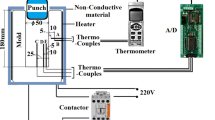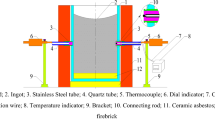Abstract
Cast aluminum alloys are usually subject to solution treatment, quenching, and aging hardening for improved mechanical properties. Cooling rate during quenching plays an important role in residual stress, distortion, and mechanical property distributions in the resultant cast aluminum components. As the cooling rates of work pieces heavily depend on the interfacial heat transfer coefficient (HTC) between work pieces and quenchants, it is important to understand how HTC varies with different quenching conditions so that optimal quenching process can be achieved. In this study, a quenching system and an experimental procedure of obtaining HTC are presented. A series of experiments have been conducted to study the variations of HTC with respect to air temperature, air humidity, air velocity, and part orientation.













Similar content being viewed by others
References
A. Rose, O. Kessler, and F. Hoffmann, Quenching Distortion of Aluminum Castings-Improvement by Gas Cooling, Materwiss. Werksttech., 2006, 37(1), p 116–121
I. Elkatatny, Y. Morsi, and A.S. Blicblau, Numerical Analysis and Experimental Validation of High Pressure Gas Quenching, Int. J. Therm. Sci., 2003, 42(4), p 417–423
Z. Li, R.V. Grandhi, and R. Srinivasan, Distortion Minimization During Gas Quenching Process, J. Mater. Process. Technol., 2006, 172(2), p 249(9)
A. Irretier, O. Kessler, and F. Hoffmann, Dry and Clean Age Hardening of Aluminum Alloys by High-Pressure Gas Quenching, J. Mater. Eng. Perform., 2004, 13(5), p 530–536
H. Li, G. Zhao, and S. Niu, Technologic Parameter Optimization of Gas Quenching Process Using Response Surface Method, Comput. Mater. Sci., 2007, 38(4), p 561–570
J.P. Holman, Heat Transfer, McGraw-Hill, New York, 2002, p 665
A.F. Mills, Heat and Mass Transfer, CRC Press, Irwin, MA, USA, 1995, p 1280
H.W. Wu and M.C. Liu, Experimental Study of Convective Heat Transfer Response to Relative Humidity in Source Arrays, Int. Commun. Heat Mass Transf., 1996, 23(8), p 1163–1172
S. Churchill and M. Bernstein, A Correlating Equation for Forced Convection from Gases and Liquids to a Circular Cylinder in Crossflow, ASME Trans. Ser. C, 1977, 99, p 300–306
M. Maniruzzaman, J. Chaves, and C. McGee, CHTE Quench Probe System: A New Quenchant Characterization System, 5th International Conference on Frontiers of Design and Manufacturing (ICFDM), Anonymous, 2002, p 619–625
S. Ma, M. Maniruzzaman, and J. Chaves, The Effects of Surface Oxides on the Quenching Performance of AlSI 4140 Steel in Commercial Mineral Oils, Proceedings of the 23rd ASM Heat Treating Society Conference, Anonymous ASM International, 2006, p 296–303
C. McGee, J. Mchugh, and M. Maniruzzaman, Gas Quenching of Steels: An Analysis of the Effects of Gas Composition and of Steel Types—4140 and 304, 1st ASM International Surface Engineering Conference and the 13th IFHTSE Congress, Anonymous ASM International, 2003, p 457–463
S. Ma, M. Maniruzzaman, and D.S. MacKenzie, A Methodology to Predict the Effects of Quench Rates on Mechanical Properties of Cast Aluminum Alloys, Metall. Mater. Trans. B, 2007, 38(4), p 583–589
The MathWorks, Inc, MATLAB (R2007B) Help Documentation, Natick, MA, USA, 2007
B. Xiao, G. Wang, and Y. Rong, Hardenability and Distortion Control in High Pressure Hydrogen Quenching, Int. J. Manuf. Res., in press
M. Still, H. Venzke, and F. Durst, Influence of Humidity on the Convective Heat Transfer from Small Cylinders, Exp. Fluids, 1998, 24(2), p 141–150
J. Ierardi, Air Property Calculator, 2000, p 1, http://users.Wpi.edu/~ierardi/FireTools/air_prop.Html, April 26, 2009
Acknowledgment
This study received partial financing support from the General Motors Company.
Author information
Authors and Affiliations
Corresponding author
Rights and permissions
About this article
Cite this article
Xiao, B., Wang, G., Wang, Q. et al. An Experimental Study of Heat Transfer During Forced Air Convection. J. of Materi Eng and Perform 20, 1264–1270 (2011). https://doi.org/10.1007/s11665-010-9745-7
Received:
Revised:
Published:
Issue Date:
DOI: https://doi.org/10.1007/s11665-010-9745-7




